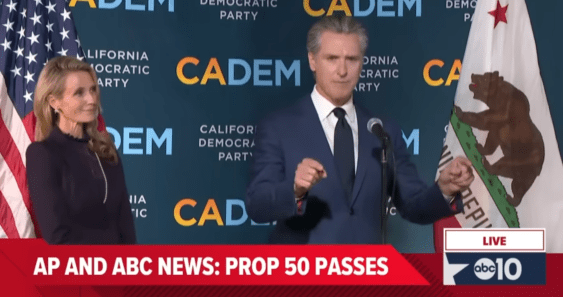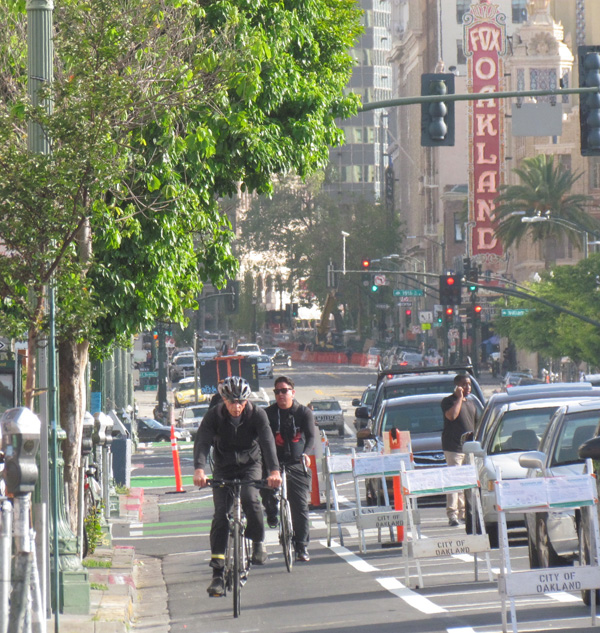
With a road diet, new parking configuration, and protected bike lanes on Telegraph Avenue, Oakland is saying to its car drivers: slow down, take it easy. And to its bike riders: you're welcome here and safe.
Not everyone is listening. The new parking-protected bike lanes have been in place for a week. In that time, it's been easy to find cars parked in them, driving in them, and blocking bus and loading zones. It will take some time for people to get used to how the new street works, but it's important to note that bad behavior is old hat on Telegraph Avenue.
Until a week ago, Telegraph had two travel lanes in each direction, plus parking at the curb, with some yellow-painted loading zones and red no-parking zones near crosswalks and at bus stops. During several afternoons of observing travel behavior prior to the changes, I saw a lot of illegal and dangerous maneuvers. At times the right-side travel lane was no more than a defacto double parking lane. Drivers would pull over, get out of their cars, and go into nearby businesses, spending five minutes or more inside. Other drivers, seeing those cars stopped, would pull up behind or in front of them and stop.

Yellow zones were frequently blocked by parked cars, and delivery vehicles double-parked. Meanwhile traffic, including bikes, buses, trucks, and cars, did not slow down, but flowed around obstacles by using the middle lanes. There were no turn lanes, so anyone turning left blocked the through-traffic if it couldn't go around on the right.
Meanwhile pedestrians had to cross four lanes of moving traffic at intersections with simple crosswalks but no traffic lights. It was a long way, and drivers frequently did not stop. Crossers had to wait until traffic in both directions was clear, and there was no place to pause in the middle of the road.
In other words, it was a busy, chaotic scene that flowed because it had a rhythm to it, but involved a fair amount of bad behavior and danger. It sort of worked for through-traffic because people found a way around obstacles, but it put everyone, especially pedestrians and bicyclists, at risk.
As of last week, with the changes almost complete, there is only one lane of through-traffic in each direction. There's also a painted median with turn lanes at many—though not all—of the cross streets, so left-turning cars can get out of the way of moving traffic. Cars no longer park at the curb—that is, they are no longer supposed to park at the curb. Instead a bike lane lines the curb, with a three-foot painted buffer to its left. Cars park left of that buffer, leaving a wide space for bikes to travel without having to mix with fast car traffic.
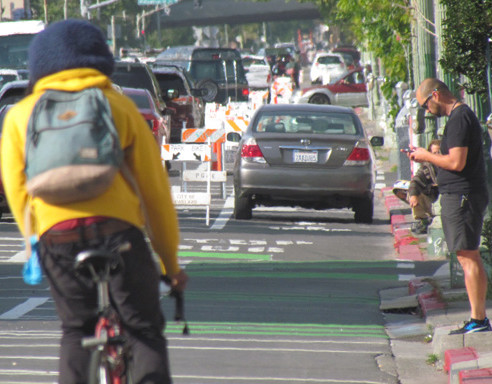
The single travel lane now accommodates buses, cars, trucks, and people lining up to parallel park. It's much harder to double park if you're blocking the only travel lane, so drivers are trying all kinds of maneuvers, including blocking the bike lane and even driving in it, between the parked cars and the curb.
Traffic is slower, because cars have to wait for drivers to parallel park. They are also stopping for crossing pedestrians and slowing down for people getting out of cars.
But people are still driving too fast, and that means honking and unsafe maneuvers--like passing over the double line to zoom past cars stopped for pedestrians or other cars.
People have plenty to say about the new lanes, although one local business owner cautioned me, “It's too early to give any opinions. I have some immediate concerns; there are loading zone issues, and some pedestrian hazards. But it will take time for people to adjust. We'll have to see.”
Others weren't shy at all about giving their opinions. A woman leaned out the passenger window of a passing van and offered, “This is some BOW-shit,” indicating the parked cars next to her.
But another woman walking past as I was unlocking my bike paused to say, “I love, love, LOVE these new lanes! This traffic starvation is WONderful.”
Clearly opinions are all over the map. “It's a lot less safe,” one local pharmacy employee told me. “Traffic is so slow now; it used to just flow fast through here all day,” she said, as if that were a good thing. She also said that she only sees “maybe five bikes a day” using the new bike lanes, although that may be because she's not outside looking for them (I saw many bikes traveling in both directions every time I was there recently).
People need time to adapt and learn. Parking-protected bike lanes are rare and clearly many people are having trouble understanding them. One van driver pulled into the bike lane and drove along it. When I asked her if she needed help, she and all her passengers talked to me at once, showing me a slip of paper with the address of a shop on Telegraph Avenue in Berkeley, a good five miles away. Maybe she was too caught up in finding the nonexistent shop to notice that she was in a bike lane. Maybe the line of parked cars to her left was such an anomaly that it didn't register.
Certainly the line of parked cars has others confused. One passerby poked his head into the Telegraph Quality Market and asked, “What going on? Is this a funeral?”
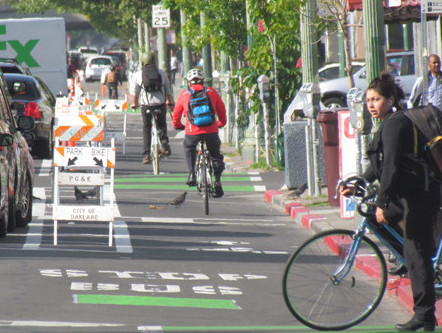
The city has put out some temporary signs to help people, with arrows pointing left to indicate “park” and right for “bike.” For the most part, though, people seem to understand what's happening. Bike East Bay has been handing out fliers thanking people for parking correctly, and reminding others how to do it right. Many people I talked to seemed to understand how it was supposed to work.
“This is really a sign that Oakland is growing up,” one man sitting in his (correctly) parked car told me. “This makes Oakland important.”
But others are having a harder time adjusting. Double parking is now pretty much impossible, so it is no longer an option for quick pickups or deliveries. People are worried about getting out of their cars right next to a lane of moving traffic. “I saw one lady almost get hit by a bus” as she got out the driver's side door, one neighbor told me.
Local merchants are concerned. They see drivers' confusion and worry it could translate into less business. For the most part, they expressed cautious support for the new bike lanes, but they're worried about the transition.
“I love the idea,” said Izzy Ahmed, who owns Burrito Express in the heart of the new section. “But I don't think they thought it all the way through.” He thinks it's harder now to cross the street, because with cars parked away from the curb, pedestrians have to step out farther before they can see oncoming traffic. As we spoke, we were standing at a newly striped zebra crossing where two cars were parked illegally close to the crosswalk, blocking sightlines.
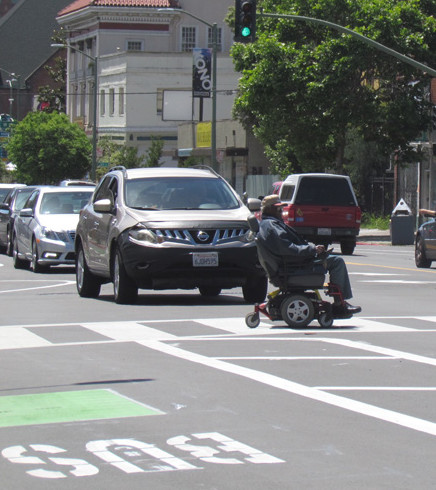
From my observations, people crossing the street now can divide up the crossing into pieces, whereas before they had to cross four lanes of moving traffic at once. Now, they first cross the bike lane; then they can pause in a space the width of a car to look for traffic coming from the left; then they cross one lane of traffic to a painted median or left-turn lane; then a second lane of traffic coming from the right, with a pause in another parked-car zone; and finally across the bike lane, this time with bikes coming from the right.
Izzy and his brother, Ahmin, also think it is harder for cars to pull out from side streets. “They can't see cars coming,” said Ahmin. Izzy pointed to a car that was pulling out to turn right onto Telegraph. The original stop line was well back from the curb, in line with the buildings, so even with the old configuration a driver could not have seen very far down the street. Here, though, the driver had to pull out past the crosswalk and into the bike lane to crane around to see whether there were cars coming towards him.
“See that? They can't see around the cars. I've seen so many near-accidents because people can't see what's coming,” he said.
But a while later, a bike rider named Molly pointed out almost the exact same situation, and she interpreted it very differently. “See that car?” she said, pointing to another one that was slowly creeping out from a side street. “The driver is forced to look in both directions before he can pull out. They never did that before! It's so much safer this way.”
Tom O'Shaugnessy, who owns Econo Jam Records, says he is excited about the new bike lanes and thinks that they are much safer for bike riders. He also says it is easier for people to cross the street, though he acknowledges that change is hard. “It will take a little time,” he said.
Kristine Shaff, with Oakland's Public Works Department, says it's everyone's responsibility to make the new lanes work. “We all need to share the road, we all need to pay attention,” she said. “We have walkers who don't even look where they're going, we have bikers who zip around people, we have car drivers who are in a mad rush to nowhere. But the traffic markings are there for a reason, and we are to obey them.”
The road diet and bike lanes are the result of an attempt to balance travel needs among all the road users, not just people in cars but also on bikes, on foot, and in buses.
“This will shift the balance in our travel behavior, and include more types of travel,” Shaff said. “We have to remember that freeways and arterials in Oakland were built to get people across and through town, not for them to spend any time in downtown. Now there's a different purpose for our roads: to get them TO destinations, which is so great for our businesses.”
“If everyone can get in the groove, we'll be all better off,” she said. “Many of us choose to live here, in an urban environment that's growing and changing, and that means changing with it.”

